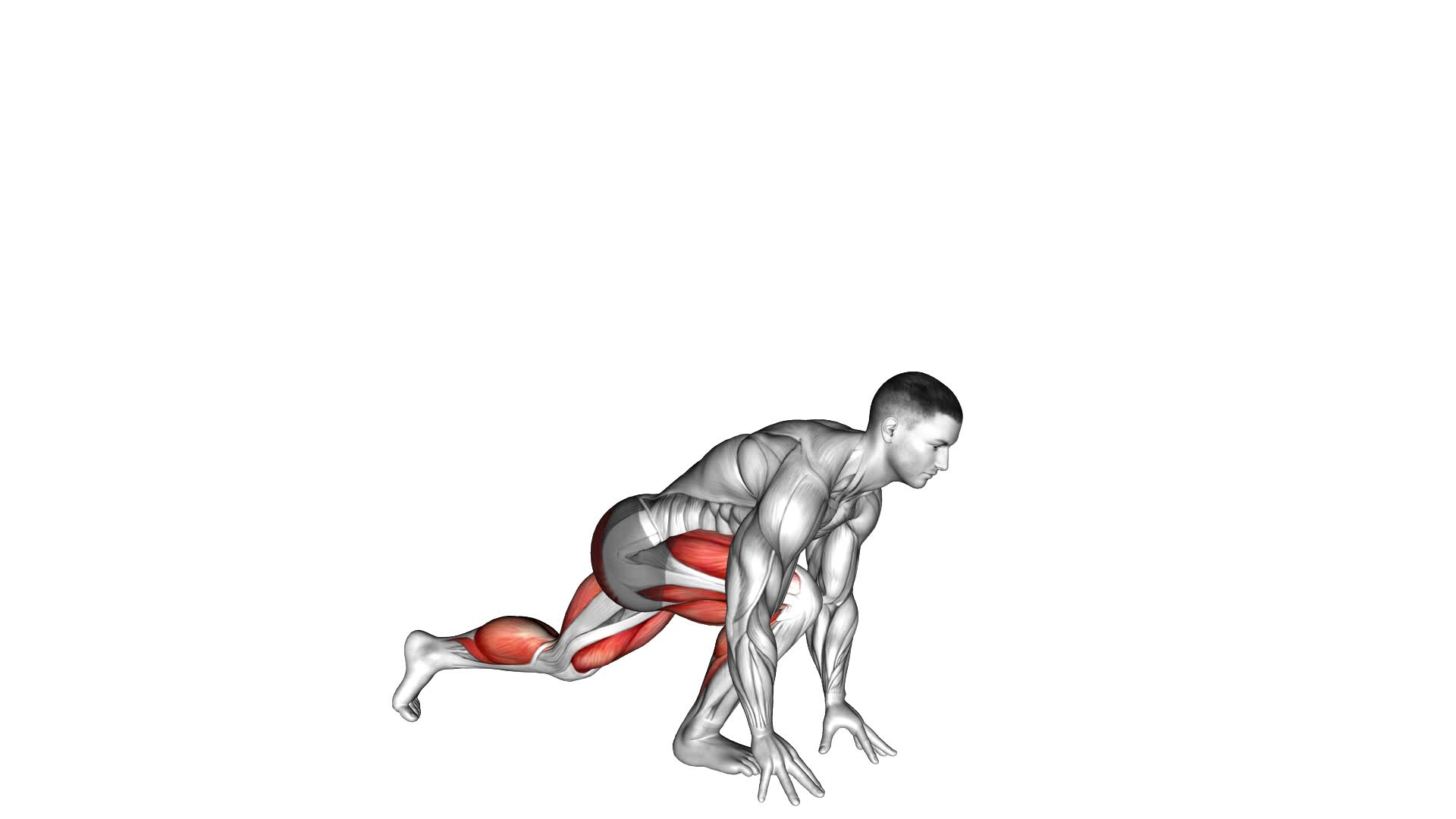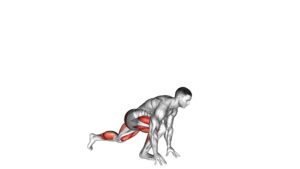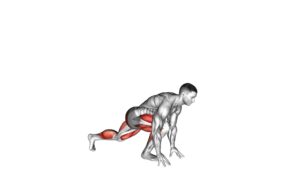Split Sprinter Low Lunge – Video Exercise Guide & Tips

Are you looking to improve your lower body strength and flexibility? Then the Split Sprinter Low Lunge is the exercise for you!
Watch This Exercise Video
In this video exercise guide, we'll show you the proper form and technique to get the most out of this challenging move. Avoiding common mistakes and learning modifications and variations will help you customize the exercise to your fitness level.
Plus, we'll provide tips on incorporating the Split Sprinter Low Lunge into your workout routine safely and effectively.
Let's get started!
Key Takeaways
- Engages lower body muscles
- Improves flexibility
- Targets quadriceps, hamstrings, glutes, and calves
- Alleviates tightness in hip flexors
Benefits of the Split Sprinter Low Lunge
Experience the numerous benefits of the Split Sprinter Low Lunge as you engage your lower body muscles and improve your flexibility. The Split Sprinter Low Lunge is a variation of the traditional lunge exercise that specifically targets your lower body strength.
By incorporating this lunge variation into your workout routine, you can effectively strengthen your quadriceps, hamstrings, glutes, and calves.
One of the key benefits of the Split Sprinter Low Lunge is its ability to challenge and improve your lower body strength. As you perform this exercise, your front leg bears the majority of your body weight, forcing your muscles to work harder to stabilize and support your body. This increased resistance helps to build strength and power in your lower body.
Additionally, the Split Sprinter Low Lunge also helps to improve your flexibility. As you step forward into the lunge position, you're required to stretch and lengthen your hip flexors, which can become tight and shortened from prolonged sitting or sedentary lifestyles. Regularly practicing this exercise can help to alleviate tightness in your hip flexors and improve your overall flexibility.
Proper Form and Technique for the Split Sprinter Low Lunge
To perform the Split Sprinter Low Lunge with proper form and technique, start by standing with your feet hip-width apart. Take a big step forward with your right foot and lower your body into a lunge position. Your right knee should be directly above your ankle, and your left knee should hover just above the ground. Keep your core engaged and your chest lifted.
From this position, explosively push off your right foot and switch legs, bringing your left foot forward and your right foot back. Repeat this motion, alternating legs, for the desired number of repetitions.
Proper form and technique are crucial when performing the Split Sprinter Low Lunge to maximize its benefits for runners. This exercise helps to improve lower body strength and stability, which can enhance running performance and reduce the risk of injury. It specifically targets the glutes, quadriceps, hamstrings, and hip flexors, all of which are important muscles for running.
To modify the Split Sprinter Low Lunge, you can perform the exercise with a shorter lunge or reduce the range of motion by not dropping the back knee as close to the ground. Additionally, you can use a support, such as a chair or wall, for balance if needed.
Remember to maintain proper form throughout the exercise, focusing on keeping your knees aligned and avoiding any excessive forward or backward leaning. By performing the Split Sprinter Low Lunge with proper form and technique, you can reap the benefits of this exercise and enhance your running performance.
Common Mistakes to Avoid While Performing the Split Sprinter Low Lunge
When performing the Split Sprinter Low Lunge, it's important to maintain your balance and form. Make sure to keep your core engaged and your chest lifted throughout the exercise.
Additionally, pay attention to your knee alignment, ensuring that it stays directly over your ankle to prevent any unnecessary strain or injury.
Balance and Form Tips
Maintain proper alignment and stability by engaging your core and keeping your front knee directly over your ankle while performing the Split Sprinter Low Lunge. This exercise requires balance and stability to effectively target the muscles in your lower body.
Here are some tips to help you maintain proper form:
- Focus on your core: Engaging your core muscles will help you maintain balance and stability throughout the movement.
- Align your front knee: Keep your front knee directly over your ankle to prevent any unnecessary strain on your joints.
- Control your movements: Avoid rushing through the exercise and instead, focus on controlled movements to ensure proper form and stability.
Proper Knee Alignment
- Ensure proper alignment of your front knee to avoid common mistakes while performing the Split Sprinter Low Lunge.
Proper knee alignment is crucial for knee injury prevention and maximizing the effectiveness of the exercise.
To achieve proper alignment, make sure your front knee is directly above your ankle and not collapsing inward or extending beyond your toes.
This will help distribute the weight evenly and protect your knee joint from unnecessary strain.
Strengthening exercises such as squats and lunges can help improve the stability and alignment of your knees.
Modifications and Variations of the Split Sprinter Low Lunge
To enhance your workout, try incorporating different modifications and variations of the Split Sprinter Low Lunge. These modifications and variations can help you target specific muscle groups, increase intensity, and add variety to your routine. Here are some options to consider:
- Split Sprinter Modifications:
- Elevate your back foot on a step or bench to increase the challenge and activate your glutes even more.
- Hold dumbbells or kettlebells in each hand to add resistance and increase upper body engagement.
- Use a stability ball against a wall for added support and balance, especially if you're a beginner.
- Variations and Progressions:
- Add a jump between lunges to incorporate plyometrics and boost cardiovascular fitness.
- Perform the Split Sprinter Low Lunge on a BOSU ball to engage your core and improve stability.
- Incorporate a torso twist at the bottom of the lunge to engage your obliques and challenge your balance.
The Split Sprinter Low Lunge offers several benefits compared to traditional lunges. It targets the glutes, quadriceps, hamstrings, and calves more intensely, allowing for greater muscle activation and strength gains. Additionally, by working each leg independently, it helps correct muscle imbalances and improve overall balance and stability.
Incorporating modifications and variations into your Split Sprinter Low Lunge routine can keep your workouts stimulating and effective.
Now, let's move on to the next section, where we'll provide you with tips for incorporating the Split Sprinter Low Lunge into your workout routine.
Tips for Incorporating the Split Sprinter Low Lunge Into Your Workout Routine
To incorporate the Split Sprinter Low Lunge into your workout routine, focus on proper form and gradually increase the intensity.
This exercise offers numerous benefits, including increased lower body strength, improved balance, and enhanced flexibility.
To ensure that you perform the Split Sprinter Low Lunge correctly, start by standing with one foot forward and the other foot extended behind you. Bend your front knee while keeping your back leg straight and your back foot grounded. Lower your body until your front thigh is parallel to the ground, making sure that your knee doesn't extend past your toes.
Engage your core and keep your chest lifted throughout the movement.
As you become more comfortable with the exercise, you can modify it by adding weights or incorporating a jump to increase the cardiovascular challenge.
Remember to listen to your body and adjust the intensity according to your fitness level.
Safety Precautions to Consider When Doing the Split Sprinter Low Lunge
When incorporating the Split Sprinter Low Lunge into your workout routine, it's important to consider safety precautions to ensure proper form and avoid injury. Here are some key safety tips to keep in mind:
- Warm up exercises: Before attempting the Split Sprinter Low Lunge, it's crucial to warm up your body. Engage in dynamic movements like leg swings, hip rotations, and walking lunges to increase blood flow and prepare your muscles for the lunge movement.
- Maintain proper form: To prevent injury, make sure to maintain proper form throughout the exercise. Keep your front knee aligned with your ankle, and avoid letting it extend beyond your toes. Keep your back straight and engage your core muscles for stability.
- Start with proper progression: If you're new to the Split Sprinter Low Lunge, start with a modified version and gradually increase the depth of the lunge as your strength and flexibility improve. This will help prevent strain or injury to your muscles and joints.
Frequently Asked Questions
How Many Calories Does the Split Sprinter Low Lunge Burn?
The split sprinter low lunge is a great exercise for burning calories. By incorporating this move into your workout routine, you can increase your calorie burn and work your lower body muscles.
However, it's important to note that the exact number of calories burned during this exercise can vary depending on factors such as your weight, intensity, and duration.
To maximize the calorie burn, you can also explore modifications and variations of the split sprinter low lunge.
Can the Split Sprinter Low Lunge Help Improve Flexibility?
The split sprinter low lunge is a great exercise for improving flexibility. By performing this exercise regularly, you can increase the range of motion in your hips and legs.
Additionally, it helps to stretch and strengthen your muscles, leading to improved muscle endurance.
To make the exercise more challenging or target different muscle groups, you can try variations of the split sprinter low lunge, such as adding weights or incorporating a twist.
Will the Split Sprinter Low Lunge Help Strengthen My Core Muscles?
Yes, the split sprinter low lunge is a great exercise for strengthening your core muscles. By engaging your core to maintain balance and stability during the movement, you're effectively working those muscles.
This exercise targets your abs, obliques, and lower back, helping to improve your overall core strength.
Incorporating the split sprinter low lunge into your strengthening exercises will provide you with a challenging and effective core workout.
Can the Split Sprinter Low Lunge Be Done by Beginners?
Yes, beginners can do the split sprinter low lunge.
It's a great exercise for building strength and flexibility.
To make it easier, you can modify the movement by reducing the depth of the lunge or using a chair for support.
Common mistakes include not keeping your front knee aligned with your ankle and not engaging your core.
Remember to start slow and listen to your body to avoid injury.
Is It Necessary to Warm up Before Performing the Split Sprinter Low Lunge?
Before performing the split sprinter low lunge, it's important for you to warm up. Warming up benefits your body by increasing blood flow to your muscles, preparing them for exercise.
Pre workout stretching can also help improve flexibility and prevent injuries. Taking the time to warm up properly can enhance your performance and make your workout more effective.
Conclusion
Incorporating the split sprinter low lunge into your workout routine can provide numerous benefits, including improved lower body strength and flexibility.
By following proper form and technique, avoiding common mistakes, and considering modifications and variations, you can maximize the effectiveness of this exercise.
Remember to prioritize safety precautions to prevent injury.
With these tips in mind, you can confidently add the split sprinter low lunge to your fitness regimen.

Author
Years ago, the spark of my life’s passion ignited in my mind the moment I stepped into the local gym for the first time. The inaugural bead of perspiration, the initial endeavor, the very first surge of endorphins, and a sense of pride that washed over me post-workout marked the beginning of my deep-seated interest in strength sports, fitness, and sports nutrition. This very curiosity blossomed rapidly into a profound fascination, propelling me to earn a Master’s degree in Physical Education from the Academy of Physical Education in Krakow, followed by a Sports Manager diploma from the Jagiellonian University. My journey of growth led me to gain more specialized qualifications, such as being a certified personal trainer with a focus on sports dietetics, a lifeguard, and an instructor for wellness and corrective gymnastics. Theoretical knowledge paired seamlessly with practical experience, reinforcing my belief that the transformation of individuals under my guidance was also a reflection of my personal growth. This belief holds true even today. Each day, I strive to push the boundaries and explore new realms. These realms gently elevate me to greater heights. The unique combination of passion for my field and the continuous quest for growth fuels my drive to break new ground.







